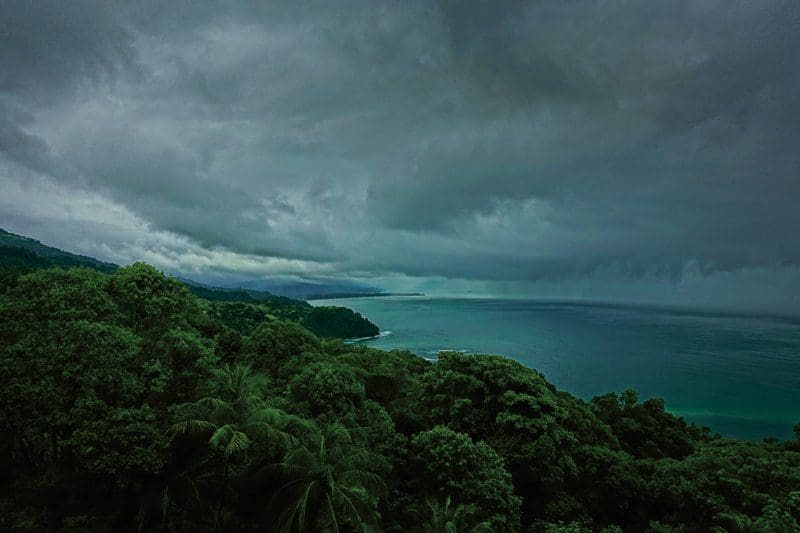
Costa Rica Climates
Costa Rica Climates, Weather in Costa Rica: What’s the weather like in Costa Rica? “Most of us are used to this question from first-time visitors or friends back in the places where we used to live. The only correct answer is, “It depends.”
It depends on where in Costa Rica you happen to be … meaning “where” in the most precise sense. Making general distinctions between beaches and mountains, or wetter versus drier regions is straightforward. But for a country that is so small in land area, Costa Rica has a dramatically disproportionate number of diverse climate areas.
Some of the world’s most diverse
and unique climate areas
are just a day trip away.
Although 32 is the oft-quoted number of so-called “microclimates” Costa Rica boasts, that terminology is technically incorrect. In fact, a microclimate can be much smaller in area, even as small as the space surrounding a tall city building. My home, for example, sits on a Pacific slope at an altitude above 800 meters. We get 30 percent less rainfall than a nearby spot just 5 kilometers up the slope. Friends a couple miles away might post that it’s pouring rain when the sun is shining on our yard.

One of the most popular systems used in Costa Rica for the classification of ecosystems is the Life Zone System developed by Holdridge. This system divides Costa Rica into 12 Life Zones and 11 Transition Zones based on environmental factors such as humidity, rainfall and temperature. There are other ecosystems found in Costa Rica that are not categorized by the Holdridge system like coral reefs and dry forest.
Within each of Costa Rica’s climate zones — also known as life zones — is an extraordinary diversity of weather conditions and ecosystems. Among this country’s most astounding wonders is that you can sample almost all of them by traveling fairly short distances and by visiting certain national or private parks.
Some of the world’s most diverse and unique climate areas are just a day trip away. Particularly notable — not just for Costa Rica but for the planet — are the contrasting tropical dry forests, coastal rainforests and barren alpine meadows, running the gamut from driest to wettest to coldest, respectively.
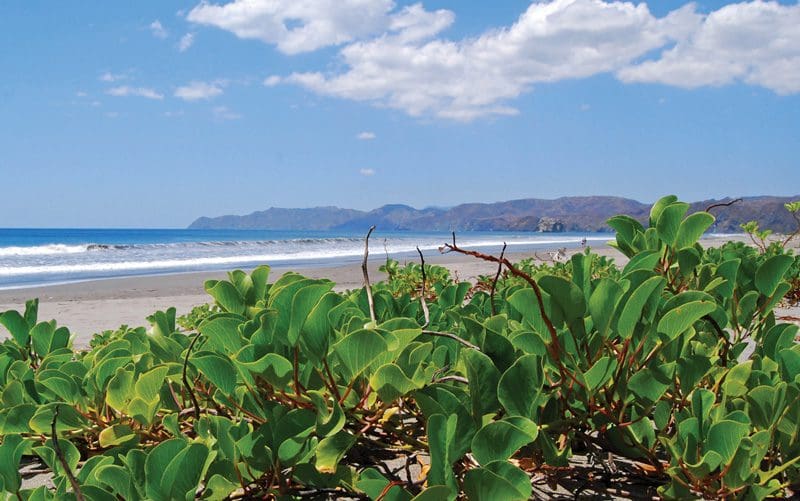
Beach at Santa Rosa National Park — Guanacaste Province, northwestern Costa Rica. Photo: Geoff Gallice
With temperatures ranging from 32°F to 100°F, and rainfall from 40 inches a year in the dry forest areas of Guanacaste to over 17 feet of rain a year in the Osa Peninsula, Costa Rica offers a diverse playground for anyone to enjoy.
Most of Nicoya and Guanacaste is covered by tropical dry forest, receiving less rainfall than anywhere else in the country. The region’s northern latitude and rain shadow effect, coupled with low altitude, contribute to its generally hot and dry climate. Some parts of northern Guanacaste receive only a few hundred millimeters of rain a year.
Santa Rosa National Park, in the far northwest tip of Guanacaste, offers a rare glimpse back in time before lumbering and cattle ranching transformed the landscape. This park contains all that remains of Costa Rica’s original tropical dry forest — just 3 percent of untouched dry, dense forest. The rest of Guanacaste has long since been turned into cattle pasture and fields of rice and cane due to the unique arid, temperate climate.
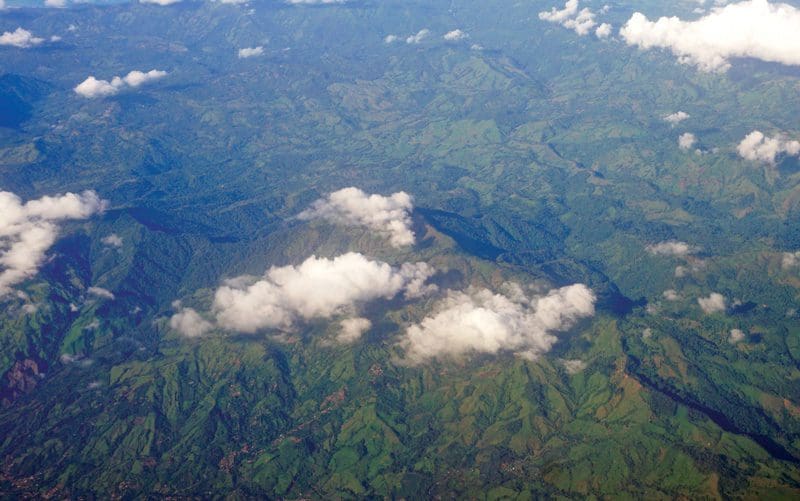
Aerial view of Los Quetzales National Park, Cordillera de Talamanca, Costa Rica.
Photo: Mario Roberto Durán Ortiz
The seasonal wetlands of Palo Verde National Park, on the southeast side of Guanacaste, make it a wildlife paradise. When the area dries up by end of April, the concentration of fauna populations intensifies, especially for birds.
Further south are Costa Rica’s wet and hot tropical wet zones — rainforests. The Osa Peninsula’s surrounding area holds some of the only remaining coastal tropical rainforests on the planet! Also remarkable is this region’s distinction as a habitat for 3 percent of the entire world’s biodiversity, due to its marine and freshwater systems. Annual rainfall in some spots here can be up to 5 meters. Corcovado National Park gives you a sense of this warm and wonderful climate zone while visiting its 13 major ecosystems, spanning in elevation from sea level to 745 meters. Endangered by economic pressures from the forestry, agriculture and gold mining sectors, the park is a UNESCO world heritage site.

Average hours of sunlight or heliophany is the measure of the number of hours that the ground receives direct solar radiation. Costa Rica has a large range of heliophany spanning from less than three hours to more than eight hours of direct sunlight.
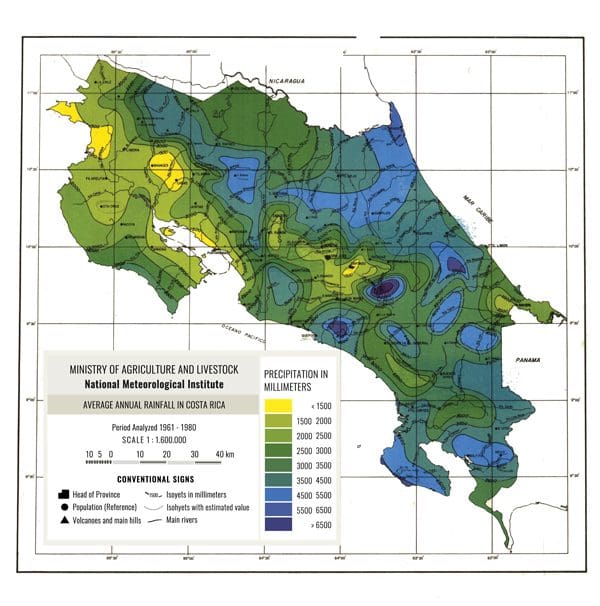
In meteorology, the volume of rainfall is measured in millimeters, equivalent to one liter of water per square meter. Costa Rica again offers a diverse range of annual rainfall. The lowest annual rainfall is 1,200 mm recorded in the North Pacific region with the highest annual precipitation of 7,500 mm in the Slope of the Caribbean. Another important maximum (7,200 mm) is located between the Barva Volcano and the Sucio River.
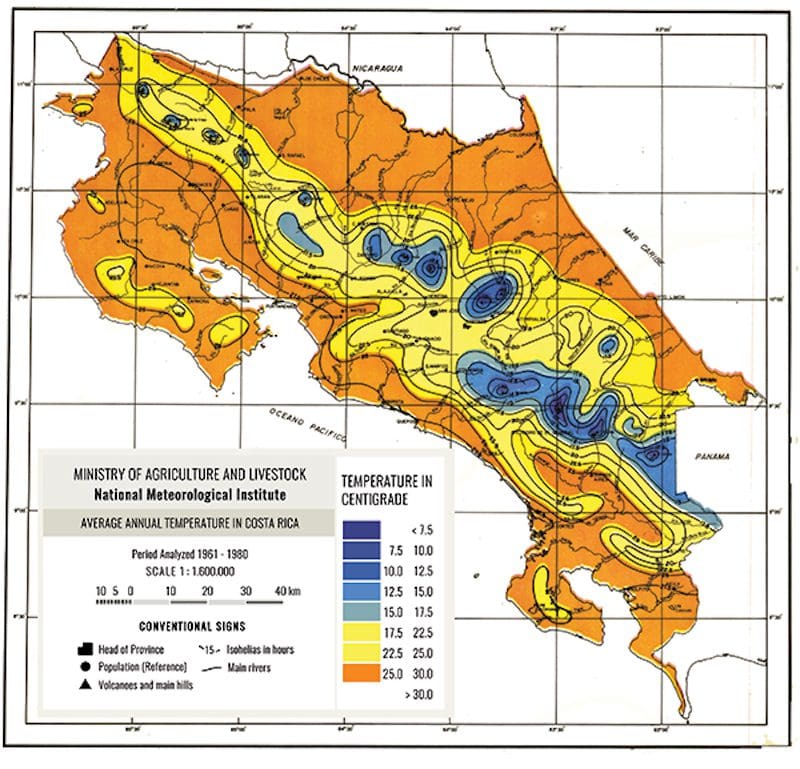
The geographical location of Costa Rica between the tropics means there is a constant average temperature above 18 ° C. The warmest regions are located on the coasts and plains, where the average temperature is higher than 26 ° C. The lowest average temperatures are located in the center and southeast of the country, specifically on the Central Volcanic Mountain Range and the Talamanca Mountain Range, where the variation oscillates between 10 ° C and 16 ° C.
Many would agree that Costa Rica’s páramo, part of Los Quetzales National Park, is the least familiar and accessible climate zone for the same reasons it’s the most distinctively different. Straddling the Panama border across the highest Talamanca mountain peaks, this tiny spread of terrain — about 20 square kilometers in total — is sparsely populated by humans but on the global list of most unique ecosystems anywhere. The páramo is aptly classified as a tropical alpine region, with Andes counterparts in Colombia and Ecuador. Natural attractions include grassland meadows, dwarf shrubs and other unusual native species of vegetation, animals and birds. The páramo area is well worth the visit. Be sure to bring warm, waterproof jacket.

The remote and tropical Tortuguero National Park is home to a large range of habitats including rainforests and beaches.
As we travel up to the Central Valley, on the Pacific slope we get cooler, but not wetter, with most moisture falling on the Caribbean side or mountaintops. This area is sheltered by the ridge of volcanoes, drier than the northern and eastern parts of the Central Valley. For an example of this somewhat higher but still dry area, visit El Rodeo Preserve at the University of the Peace in Cuidad Colón. The Central Valley overall is a dynamic system where the western side is 500 meters lower than the eastern side. The weather difference between Tibás and Guácima is pretty dramatic in terms of rain and temperatures.
Heading more north, we find that warmer Caribbean waters feed moisture almost constantly, regardless of the season. As noted, the mountain slopes on the Caribbean or eastern side are wet, with premontane wet or moist forests. Arenal National Park and La Fortuna are good examples. Then we get into the large flat area of the northeast from around Upala to Límon, which experiences heavy rains and warm temperatures of the Caribbean tropical zone. A beautiful and remote place such as Tortuguero National Park, or the everglades-like wetlands of Caño Negro, are perfect to experience this region’s tropical wet climate.
Costa Rican Army Abolished: One more reason for happiness?
Feature Article – Living longer in Costat Rica Blue Zone
Costa Rica Yoga and Wellness Retreats
Yoga Wisdom – Power of Yoga: Yamas and Niyamas
Yogapedia – Vrksasana: Tree Pose
Natural Medicine – CBD Oil: Nature’s Miracle Cure?
Mindfulness: Natural High: Benefits of Nature
Psychological Well Being – Counseling Help in Costa Rica
Eat Well: Costa Rica Superfoods – Nutrient Dense Food
Costa Rica Medical Tourism
Costa Rica Dental Tourism: Veneers – Reason to Smile
Ecotourism in Costa Rica: Sustainable Tourism
Ecotourism Pioneer: Rafael Gallo – Ríos Tropicales
The Osa Peninsula
Ecotourist Road Trip: Sarapiquí
Ecolodges in Costa Rica
Caminos de Osa: Tourism that is helping Costa Ricans
CST Being Green Matters to Diamante Eco-Adventure Park
Grow Sustainably, Build & Live Sustainably in Costa Rica
Behind the Image: Photography as Ecotourism
Building Green and Prove it in Costa Rica
Costa Rica Sustainable Development: Ever Greener
Costa Rica’s indigenous Communities and Indigenous Tribes
